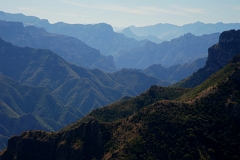|
|
|
|

Sunset un Barranca Del Cobre. View from our balcony
One day, we took the cable car (teleferico) down into the canyon. The teleferico is part of a new project by the Mexican government to develop tourism in the region. For 250 pesos ($20US), the trip was well worth it. It is hard to imagine how remote (and far) this part of Mexico is from real civilization. There are communities (Raramuris –indigenous people-) living at the bottom of the canyon, which is a 6-10 hour walk before reaching the rim of the canyon. From the summit of the canyon (where we were staying), it was 60km to the closest ATM and 20km to the closest pharmacy! Treated drinkable water is now being installed to the villages (as of December 2010) on the summit of the canyon and phone lines exist only since last year. |
Going back to Torreon from there was an adventure in itself. We had no more cash (money) with us, so taking the train was impossible. We took a bus from Posada Barrancas to Creel. The road was curvy and vomit bags was the norm rather than the exception. From Creel, we were hoping to get the daily train back to Chihuahua, but after waiting for more than 5 hours in Creel, a lady came up at the train station and told us that the train was 6 hours late. We decided that getting into Chihuahua at 1-2am with the train was not the best option (with all the violence happening in northern Mexico right now). |
Who are the Raramuris?
The Rarámuri or Tarahumara are indigenous people of northern Mexico who are renowned for their long-distance running ability. Originally inhabitants of much of the state of Chihuahua, the Rarámuri retreated to the Copper Canyon in the Sierra Madre Occidental on the arrival of Spanish explorers in the sixteenth century. The area of the Sierra Madre Occidental which they now inhabit is often called the Sierra Tarahumara because of their presence. Current estimates put the population of the Rarámuri in 2006 at between 50,000 and 70,000 people. Most still practice a traditional lifestyle, inhabiting natural shelters such as caves or cliff overhangs, as well as small cabins of wood or stone. Staple crops are corn and beans; however, many of the Rarámuri still practice transhumance, raising cattle, sheep, and goats. (taken from Wikipedia) |
 |